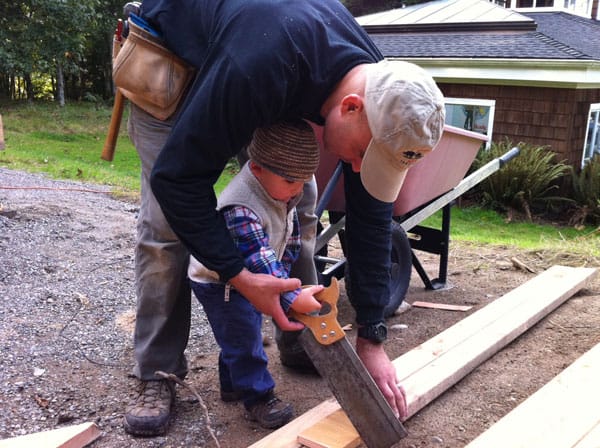
We believe that children should be introduced to hand tools at an early age and as they get older continue to educate them on how to safely use tools while making repairs or completing projects.
The hand saw is one of the most basic tools found in every toolbox and despite it’s somewhat threatening appearance it’s an extremely safe tool to use. Teaching a child how to use a hand saw safely is important as they quickly develop respect for the tool and realize how effective it is as well as it’s limitations.
Beyond the typical safety instructions for using a hand saw that children and adults should follow, we recommend these safety tips when instructing your child on how to use a hand saw.
1. Fit
Make sure the saw used will fit their hand and is specific to their age and weight. In the above photo this child is being introduced to a hand saw for the first time, but as a toddler doesn’t really know what he’s doing but it’s still important as it’s working on his motor skills and sensory as he can touch the wood, blade and teeth.
2. Tool Check
Make sure the tool you introduce to your child is in good operating condition and the wood handle is free from any burrs or splinters and is securely attached to the metal blade. The blade and teeth should be clean and free from rust, sap or anything else that may hinder its performance.
3. Eye Protection
Introducing safety goggles will create a habit that will serve you and your child as they grow and begin to make longer cuts and work with more dangerous tools.
4. Common Sense
Never leave your young child unattended with a saw (or any tool for that matter). Use your own judgment as to what age you feel is appropriate for your child to hand tools unsupervised.
Here are other hand saw safety tips from OSHA that everyone should follow.
* Wear safety glasses or goggles, or a faceshield.
* Select a saw of proper shape and size for stock being used.
* Select a saw with the number of teeth per inch (TPI) in order to get the desired finish. For example: a coarse tooth blade (e.g., 2 or 3 TPI) should be used for thicker stock. 18 to 32 TPI should be used on thinner metals or plastic (0.5 cm or 1/4 inch). General wood cutting typically requires about 4 TPI.
* Choose a saw handle that keeps wrist in a natural position in the horizontal plane.
* Choose saw with a handle opening of at least 12 cm (5 in.) long and 6 cm (2.5 in.) wide and slanted at a 15° angle.
* Check the stock being cut for nails, knots, and other objects that may damage or buckle saw.
* Start the cut by placing your hand beside the cut mark with your thumb upright and pressing against blade. Start cut carefully and slowly to prevent blade from jumping. Pull upward until blade bites. Start with partial cut, then set saw at proper angle.
* Apply pressure on downstroke only.
Saw – Cutting Angles
* Hold stock being cut firmly in place.
* Use a helper, a supporting bench or vise to support long stock if required.
* Keep teeth and blades properly set.
* Protect teeth of saw when not in use.
* Keep saw blades clean.



